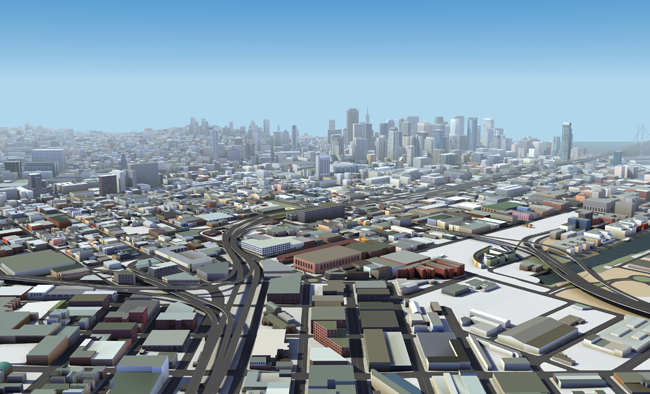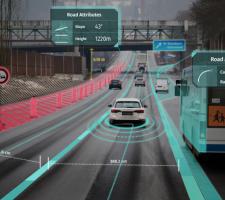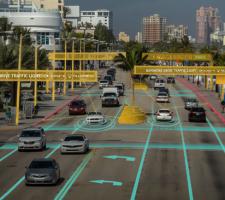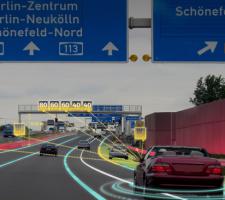
5G is a hot topic worldwide, with the potential for faster transfer of information eagerly awaited by those convinced that it will be a game-changer for the ITS industry.
High-definition (HD) maps are essential to allow autonomous vehicles (AVs) to understand their environment, and operate safely within it in relation to other road users and pedestrians. Given the information required to be transmitted and received – for example, constantly identifying permanent and temporary road infrastructure - many companies believe that 5G is essential for this. But Matt Preyss, product marketing manager for
However, he does recognise that 5G will help: “We are talking about terabytes that’s going to be sent to the cloud. If you’re talking about a situation where there’s an accident, a little bit of information like that could be sent to the cloud.”
The company’s solution is a three-layer model, the Here HD Live Map for Autonomous Driving. The first layer is a road model to understand rules such as the location of high-occupancy vehicle (HOV) lanes, areas where there are no left turns, the shoulder lanes and how many lanes are actually on the road.
The second layer is the lane model which includes everything related to the lanes such as marking and width. Meanwhile, the final layer - the localisation model - comprises road objects, sign faces, pole-like objects or barriers.
Crowdsourced data
Preyss reveals that each of the three layers of the map is built in 2km by 2km tiles. “If there’s changes to the map, only the tile in that layer [will be changed],” he says. “So if it’s only a road sign, you’re only sending the third layer of information in that little tile; we’re talking kilobytes of data which are really small packages.”
To gather data, Here uses what Preyss describes as a “two-pronged approach” in which the company’s vehicles map the road using Lidar, GPS and cameras to take pictures.
“The lane lines, if they change, if the city came out and needed lane lines or bus lanes or bike lanes, that all needs to be reflected in the map,” he adds.
Crowdsourced data is also used to build the map, which can come from cameras on customer vehicles, and radar sensors as well as third parties which want their drivers to use mobile phones to take recordings.
However, Preyss insists that there is a lack of vehicles using sophisticated sensors although this will change as original equipment manufacturers (OEMs) become more involved. He suggests that “as the OEMs come to install these sensors more cars will be equipped with them and be able to provide us with data to keep the map up to date”.
Structure differentiation
For differentiating between temporary and long-term structures, Here works with its customers to determine what is needed on the map.
“If they want to use a camera sensor that’s reliant on lane lines and road signs, that’s what we will support,” he continues.
Here also provides information on the road boundary ends and uses Lidar data to collect bus parking spots which appear on the map as features which can be added for customers.
According to Preyss: “The biggest hurdle is that if we get a request for a certain feature it is again that quality that needs to be there - and accurate in centimetres - to make sure the vehicle has proper information.”
Consumer trust is a major issue when it comes to all aspects of AVs – and Here’s Quality Index provides a predictive score which rates how far map data reflects reality.
Preyss says: “A high score shows that the data reflects reality, but the Quality Index score drops in environments which have changed or areas where we haven’t had any validations from cars because it’s a closed or rural road.”
Once the score drops below a certain threshold, the vehicle can either rely on its sensors or hand control back to the human driver to be more proactive - to avoid a split-second decision - where manual intervention is required within 30 seconds.
Drifting issues
In the back end, the Quality Index is used to assess high-quality data provided by Lidar and data that is considered lower in quality which comes from camera phones. If a car cannot see a road sign which was installed three months ago, for example, Here says it can look at what it is seeing, whether it be a tree branch covering the sign or if someone may have taken the sign out.
Data exchange
Here Technologies’ OLP Marketplace is a hub for global location data exchange across industries. It allows companies or organisations that have a large collection of sensor data to share with others which are creating new location-based applications and solutions for people and enterprises.
Christof Hellmis, vice president strategic programme management, says companies need time to try out different ideas and see what works. In the marketplace, data consumers can build applications and solutions for people and enterprises by accessing standardised data from trusted providers, licensing data that Here has aggregated and harmonised from multiple sources and use the OLP Workplace, as an option for faster product development.
For data providers, the OLP Workplace offers standards-based normalisation and enrichment tools to ensure data can easily be consumed by others.
“If you’re an OEM and you have connected vehicles, you may get a lot of data from these vehicles, you may want to create own services that are more specific such as more maintenance or range,” Hellmis explains. “You may also want to find other opportunities to monetise the data that you create and that’s where the marketplace comes into play.”
Currently, OEMs can create their own data marketplace to get access to data for a specific OEM brand. “If I’m a developer I may want to develop specifically for more OEMs so I want to have a broad range,” he continues. “Or one OEM may be strong in Europe but weak in North America, but the developer may want to push out a service in both locations and have to go to another marketplace.”
Hellmis recognises that participants are trying things out and the marketplace will take time, as people need to figure out what types of data have higher value.
“We’ve just effectively launched an ecosystem where many players, friend or foe, can participate and drive it forward,” he beams. “We believe this step is very important, but it will not be successful in a few weeks. But once they are up and running they are very powerful.”
Preyss warns that issues can arise on highways when the lane line that is being measured starts to expand when curving out into an exit lane – causing the cars to drift.
“With our solution, we have that lane information, we know the lane continues - and we’ve done tests which make sure the car with that lane information stays comfortably in it.”
Preyss insists that the technology must be able to handle these simpler use cases to win consumer trust. The potential of 5G continues to be a hot topic, with companies like Samsung Electronics and Waymo locked into heavy debates about its potential benefits for road safety in smart communities and ride-hailing services, but the perspective offered by Preyss does shed some light on what can be done before 5G’s arrival.












